The practice of medicine today involves an immense amount of administrative work, particularly clinical documentation. Healthcare providers find themselves drowning in a sea of clicks and keystrokes, spending disproportionate amounts of time interacting with electronic health records (EHRs) rather than their patients. Statistics paint a stark picture: physicians often dedicate nearly two hours to EHR tasks and desk work for every single hour spent delivering direct patient care.
This documentation burden has escalated dramatically, increasing by 25% since 2015, with clinicians now spending an average of 13.5 hours per week solely on paperwork. This isn’t just an inefficiency; it’s a major contributor to the alarming rates of physician burnout, with over half reporting burnout symptoms and a staggering 83% attributing it directly to their job demands, primarily the administrative load. The financial toll is significant, with burnout costing the healthcare system hundreds of millions annually.
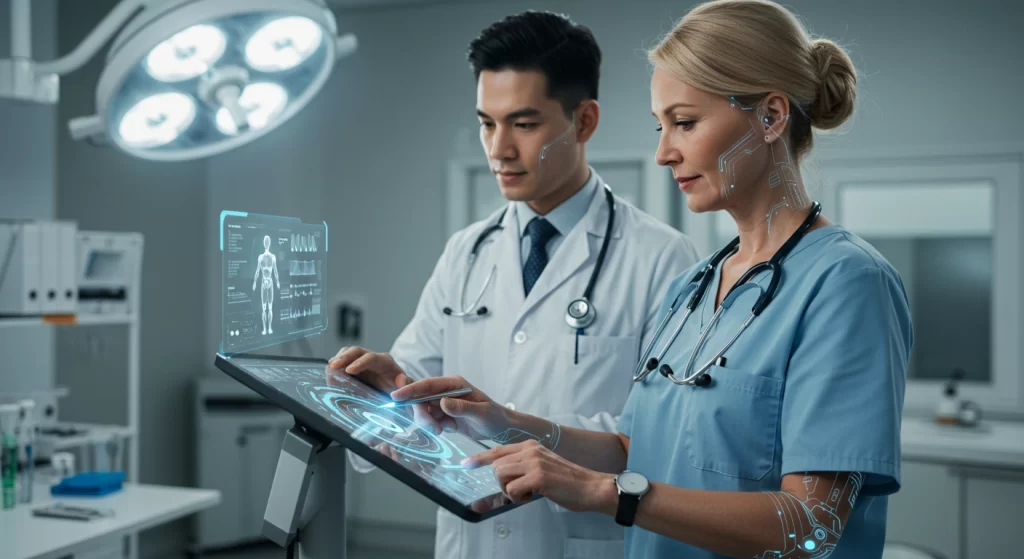
In response to this escalating crisis, a powerful technological solution has emerged: the AI medical scribe. At its core, an AI medical scribe is an advanced software tool, powered by artificial intelligence, designed to automatically generate clinical notes directly from the natural conversations that occur between healthcare providers and their patients. It represents a paradigm shift, moving documentation from a manual, time-consuming chore to an automated, background process.
This article provides an expert analysis of the AI medical scribe phenomenon. It delves into how this technology is fundamentally reshaping clinical documentation, exploring the underlying mechanisms, the significant benefits medical scribe AI offers, the challenges that must be navigated, the dynamic market landscape, and the future trajectory for AI scribe for medical notes.
Overwhelmed by documentation? Discover how SPsoft’s expertise in developing custom healthcare AI tools, like advanced AI medical scribe solutions, can streamline your workflows!
What Is an AI Medical Scribe?
An AI medical scribe leverages artificial intelligence to listen to, transcribe, interpret, and structure the dialogue between physicians and patients during clinical encounters. Its primary function is to automate and streamline the creation of clinical notes, often integrating these notes directly into the practice’s Electronic Health Record (EHR) system.
Crucially, an AI medical scribe is far more sophisticated than basic dictation software or traditional transcription services. It employs advanced technologies like Natural Language Processing (NLP) and Machine Learning (ML) to understand the clinical context of the conversation, filter out irrelevant chatter (like greetings or casual small talk), identify key medical information, and format the output into structured, clinically relevant scribe AI notes. It aims not just to capture words, but to capture meaning and organize it usefully.
Comparison: AI Medical Scribe vs. Traditional Human Scribes
Understanding the value of an AI medical scribe requires comparing it to the established alternative: human medical scribes.
- Human Medical Scribes. These are trained professionals who assist clinicians by documenting patient encounters in real time, either in person or virtually. Their strength lies in understanding nuance, interpreting non-verbal cues, and asking clarifying questions. However, human scribes represent a significant operational expense, including salary, benefits, recruitment, training, and management overhead. They are also subject to fatigue, inconsistencies, and scalability limitations.
- AI Medical Scribe. As software, the AI medical scribe offers substantial cost advantages, typically operating on a subscription model ($99 to $299 per provider per month, or $1,080 to $3,500 annually). AI medical scribes are highly scalable, provide consistent output, are available 24/7, and often include strong security features. However, AI currently struggles with subtle human interaction, accents, background noise, and can make errors, including “hallucinations” (generating incorrect information).
The choice involves a trade-off: AI excels in speed, consistency, scalability, and cost, ideal for high-volume or routine encounters. Human scribes offer superior contextual understanding and adaptability, potentially better for complex cases, despite higher costs.
Table 1. AI Medical Scribe vs. Human Medical Scribe
| Feature | AI Medical Scribe | Human Medical Scribe |
|---|---|---|
| Cost | Lower (e.g., $99-$299/month/provider) | Higher (e.g., ~$33k-$55k+/year + overhead) |
| Speed | Very Fast (Real-time/Near Real-time) | Slower (Manual documentation speed) |
| Accuracy | High potential, consistent; prone to specific errors (hallucinations) | Variable (skill/fatigue); better at error correction |
| Scalability | High (Software-based) | Low (Requires hiring/training) |
| Consistency | High (Uniform output) | Variable (Depends on individual) |
| Contextual Understanding | Limited (Struggles with nuance/non-verbals) | High (Can interpret context, ask questions) |
| Availability | 24/7 | Limited (Work hours, breaks, sick days) |
| Compliance Focus | Often built-in (Encryption, audit trails) | Requires training and oversight |
| Training Time | Minimal user training; AI model may need tuning | Significant initial training required |
Comparison: AI Medical Scribe vs. Dictation & Transcription
The AI medical scribe also surpasses older methods like dictation and traditional transcription.
- Dictation. Physician records notes verbally; requires manual typing later. Slow and add steps.
- Traditional Transcription. Humans listen to recordings and type them. Introduces delays (hours/days), is costly (per minute/line), and quality varies.
- AI Medical Scribe. Offers near real-time note generation directly from the encounter. Integrates contextual understanding and structuring, producing clinically useful documentation faster and often cheaper than traditional transcription.
This shows an evolution: dictation captured voice, transcription converted it to text, but the AI medical scribe interprets the conversation and integrates the information seamlessly.
The Engine Behind the Scribe: Key Techs Powering Medical Scribe AI
The capabilities of an AI medical scribe rely on several sophisticated AI technologies.
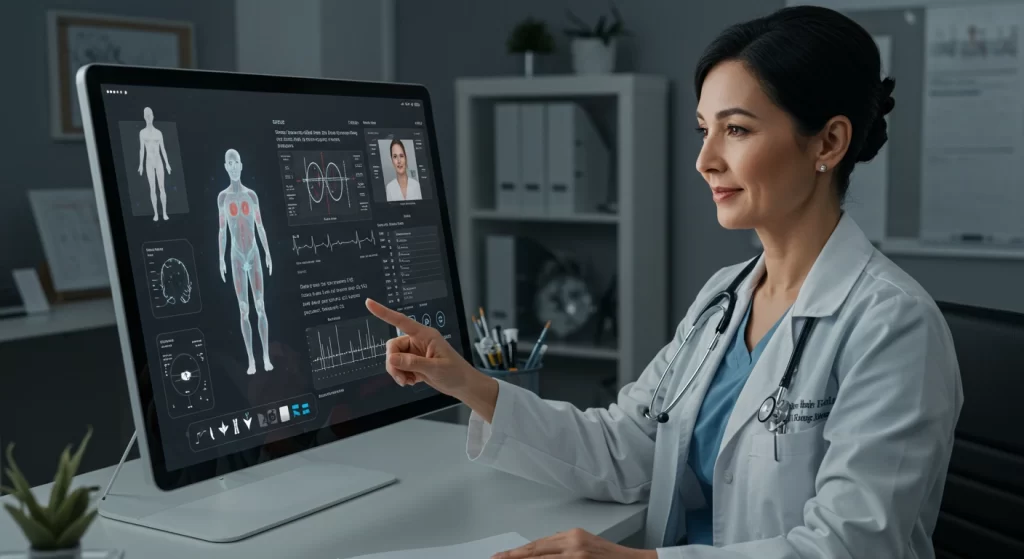
Automatic Speech Recognition (ASR): Listening Intelligently
ASR is the foundation, converting spoken words into digital text. Modern ASR uses deep learning (Transformers, Conformers) for improved handling of accents, noise, and multiple speakers, with vendors claiming high accuracy (e.g., >95%). However, challenges remain with complex medical terms, diverse accents, noisy environments, and achieving perfect accuracy. Word error rates (WER) still exist, and ASR errors can negatively impact the final note. Accurate ASR is critical but only the first step for generating useful scribe AI notes.
Natural Language Processing (NLP): Understanding Context and Meaning
NLP interprets the meaning and context of the transcribed text. It analyzes the text to:
- Identify key clinical information (symptoms, diagnoses, medications).
- Filter irrelevant content (greetings, small talk).
- Understand context and relationships between words.
- Structure data into formats like SOAP notes.
- Standardize terminology (converting abbreviations or layman’s terms).
NLP techniques like Named Entity Recognition (NER) and semantic analysis bridge the gap between raw text and a structured, meaningful clinical document. The sophistication of NLP determines how well the medical scribe AI replicates human interpretation for valuable scribe AI notes.
Machine Learning (ML): Getting Smarter Over Time
ML adds an adaptive layer, allowing the AI medical scribe to learn and improve from usage patterns and clinician feedback. As physicians edit notes, ML models adapt to:
- Individual preferences (note structure, phrasing, detail).
- Speech patterns (accents, dialects).
- Specialty terminology.
This continuous learning leads to higher accuracy and personalization, making the tool fit more seamlessly into the clinician’s workflow, which is crucial for adoption.
How AI Medical Scribes Revolutionize Clinical Note-Taking
The integration of AI medical scribe technology drives significant changes by addressing documentation pain points.
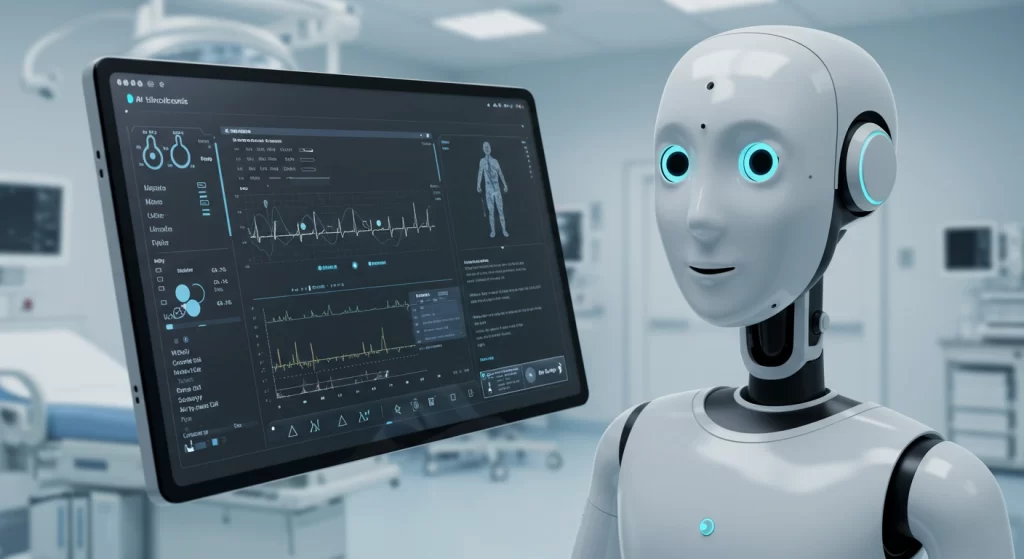
Slashing Documentation Time & Boosting Efficiency
A primary benefit of AI medical scribes is drastically reduced documentation time. Reports highlight:
- Significant daily time savings (1 to 3+ hours).
- Reductions of 50-75% in documentation time claimed by some systems.
- Large-scale savings (e.g., Permanente Medical Group saved the equivalent of 1,794 working days in one year).
This boosts efficiency, enabling same-day note completion and potentially reducing “pajama time” (after-hours charting), though results on the latter vary. Some studies show significant reductions (e.g., 72%, 60%, 48%), while others report mixed results. Vendors like DeepScribe claim chart closure times as fast as 1.6 minutes.
AI medical scribes streamline workflows by automating note creation and integrating with EHRs, reducing administrative friction. This efficiency might allow seeing more patients (e.g., 1-3 extra per day), though this depends on how saved time is used.
While time savings are consistently reported, the actual magnitude, especially for after-hours work, varies based on the tool, clinician workflow, specialty, and integration quality.
Combating Clinician Burnout: Restoring Joy to Practice
Heavy documentation workload is a primary driver of clinician burnout, leading to decreased job satisfaction, errors, and clinicians leaving the profession.
AI medical scribes are seen as crucial tools against burnout. By automating time-consuming documentation, they reduce administrative burden, freeing up mental energy for clinical reasoning and patient interaction.
Positive impacts on well-being are emerging:
- Mass General Brigham reported a 40% relative reduction in burnout in a pilot.
- MultiCare clinicians reported a 63% reduction in burnout and 64% improvement in work-life balance.
- A broader study found users reported a 61% reduction in documentation stress and 54% improvement in work-life balance.
- Permanente Medical Group found 82% of physicians using AI scribes reported improved overall work satisfaction.
The ability of medical scribe AI to reduce burnout and improve well-being is a compelling value proposition, often driving adoption more than immediate financial gains, especially for systems facing workforce shortages.
Enhancing Documentation Quality and Accuracy with Scribe AI Notes
AI medical scribes potentially improve documentation quality and accuracy. Vendors claim high accuracy (95-98%), and AI may produce more complete notes than rushed clinicians, capturing details missed later. One study found AI documentation included 22% more relevant findings. Yale New Haven Health reported clinicians kept about 80% of AI-generated drafts, suggesting high initial utility.
AI ensures consistency through templates and standardized terminology, improving clarity and communication.
However, accuracy needs scrutiny. AI errors include:
- Transcription Errors. Mishearing terms, drug names, or speakers with accents/noise.
- Omissions. Missing critical information.
- Contextual Misinterpretations. Misunderstanding clinical meaning.
- “Hallucinations”. Generating plausible but fabricated details (reported rate of 7% in one study).
Some physicians find AI notes verbose or lacking their “voice”. These issues necessitate thorough clinician review and editing before finalizing any AI-generated scribe AI notes in the EHR. AI assists, but doesn’t replace clinical judgment.
Improving the Patient-Provider Relationship
AI medical scribes can enhance the human connection by removing the EHR screen barrier. By handling documentation, they allow clinicians to:
- Maintain eye contact.
- Listen actively to the patient’s story and non-verbal cues.
- Foster natural, empathetic conversation.
Patients notice and appreciate this. Permanente Medical Group found 47% of patients reported less computer time and 39% felt the doctor spent more time speaking directly to them. A Stanford study found 92% of patients preferred visits with AI scribes. This improved interaction can lead to better understanding, information gathering, stronger alliances, and potentially better outcomes. AI, in this case, can make the encounter feel more human.
The Financial Equation: Cost Savings and ROI Potential
Financial implications are critical.
- Direct Cost Savings. AI subscriptions ($99-$299/month per provider) are significantly lower than human scribe costs ($33k-$55k+/year + overhead), potentially saving 60-75% or more. Pricing models vary (unlimited use like Freed vs. usage-based like AWS HealthScribe).
- Potential Revenue Generation. Saved time can potentially be used to see more patients (1-3 extra/day, potentially boosting revenue by $750/day or $125k-$200k/year per physician). More comprehensive AI scribes for medical notes can support accurate coding (ICD-10, CPT, HCC), improving reimbursement. Suki AI claims users see 5% higher encounter volume ($54k extra annual revenue/user).
- ROI Challenges. Demonstrating consistent financial ROI has been challenging. PHTI found limited evidence. Many organizations are in pilot phases, and saved time is often used to reduce burnout rather than increase throughput.
- Indirect Savings: Reduced overtime, less time correcting errors, and potentially lower turnover due to reduced burnout contribute to indirect savings.
The value perception is evolving from direct cost savings to burnout reduction. Consistently demonstrating quantifiable financial ROI (improved coding, optimized throughput, reduced downstream costs) will be crucial for long-term investment.
Navigating the Landscape: Types of AI Medical Scribe Solutions
The AI medical scribe market offers various solution types.
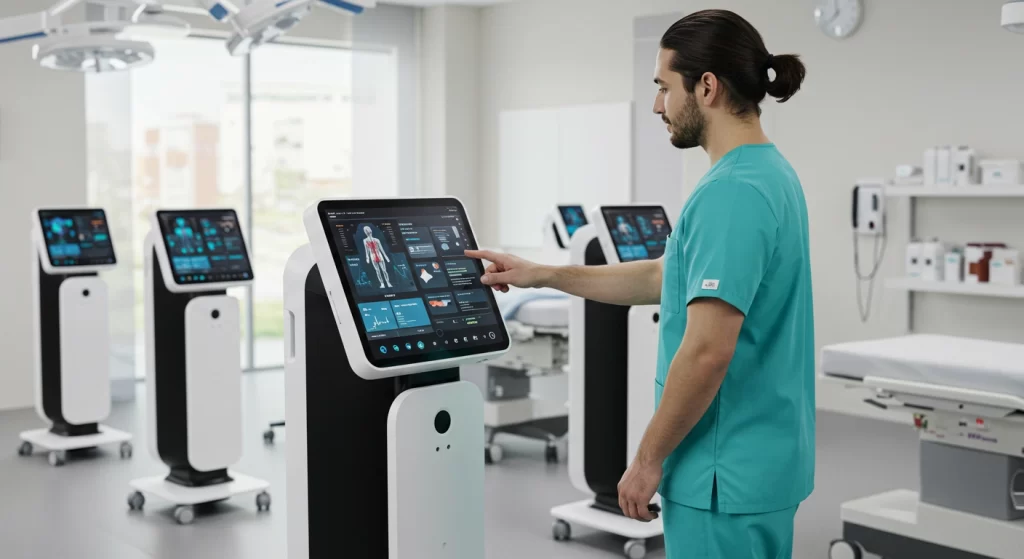
Ambient AI Scribes: The Invisible Assistant
Ambient AI scribes offer a hands-off approach.
- Mechanism: Microphones in the exam room passively listen to the entire conversation, operating in the background without clinician commands. Goal: “invisible assistant”.
- Pros: Maximizes patient focus, fosters natural interaction, captures comprehensive information, minimal interaction required.
- Cons: Can be more expensive, might capture sensitive side conversations or noise, effectiveness depends on microphone/acoustics, less user control over recording.
- Examples: Abridge, Ambience Healthcare, DeepScribe, Microsoft (Nuance DAX Copilot), Nabla, Suki.
Ideal for maximum patient focus, but cost, environment, and control needs might favor other types.
Voice-Activated & App-Based Scribes: Command and Control
These require explicit user interaction.
- Mechanism: Clinicians initiate/conclude recording via app button, wake word, or verbal commands. Often run on standard devices (smartphones/tablets).
- Pros: More cost-effective, greater user control over recording, highly portable, minimal specialized hardware.
- Cons: Requires active management during encounter (potential distraction), might capture less comprehensive info if not activated fully, may require learning commands.
- Examples: Freed AI, Tali.
A trade-off: less passive convenience for more control, portability, and lower cost. Attractive for smaller practices or budget-conscious organizations.
Hybrid Human-AI Models: The Best of Both Worlds?
Merges AI with human expertise.
- Mechanism: AI performs initial transcription/drafting; a trained human scribe reviews/edits before delivery to the clinician.
- Pros: Aims for highest accuracy (>99% claimed) by leveraging human judgment, potentially faster implementation, combines AI speed with human reliability.
- Cons: More expensive than pure AI, slightly longer turnaround than instant AI (but faster than human-only), effectiveness depends on human reviewer quality/availability.
- Examples: ScribeEMR.
Appealing for those hesitant about full AI reliance due to accuracy concerns, offering a perceived higher reliability at a higher cost.
Generating Clinical Notes from Encounters (AI scribe meeting notes)
Regardless of type, the goal is generating accurate clinical documentation from the patient encounter. “AI scribe meeting notes” refers to the structured clinical notes (SOAP, progress notes) produced by the AI medical scribe based on the patient visit (“meeting”).
The process involves:
- Transcription. ASR converts speech to text.
- Interpretation & Filtering. NLP/ML identify clinical info, filter non-clinical talk.
- Structuring & Formatting. Data organized into standard formats (e.g., SOAP).
- EHR Population. Structured data integrated into EHR fields.
Advanced AI medical scribe systems learn and adapt to clinician preferences (style, detail, templates), making generated scribe AI notes feel more natural over time. The success hinges on the quality and utility of the final “AI scribe meeting notes”.
Table 2. Comparison of AI Medical Scribe Types
| Feature | Ambient AI Scribe | Voice-Activated/App-Based Scribe | Hybrid Human-AI Scribe |
|---|---|---|---|
| Activation Method | Passive Listening (Always On) | Active Command/Button Press | AI Transcription + Human Review |
| Clinician Interaction during Visit | Minimal/None | Required for Start/Stop/Commands | Minimal/None (Interaction is post-encounter review) |
| Cost Level | Higher | Lower | Highest |
| Control Level | Lower (Less direct control over recording) | Higher (User controls recording) | Varies (Control over final note via review) |
| Potential Comprehensiveness | Highest (Captures entire conversation) | Variable (Depends on activation duration) | High (AI capture + human refinement) |
| Key Pro | Natural interaction, Max patient focus | Cost-effective, User control, Portable | Highest potential accuracy, Human oversight |
| Key Con | Higher cost, Less control, Env. dependent | Requires active management, Potential distraction | Highest cost, Slightly longer turnaround |
Challenges and Limitations of AI Medical Scribes
Despite compelling benefits, organizations must address significant challenges.

Accuracy, Errors, and the “Hallucination” Problem
Errors remain a primary concern:
- Transcription Errors. Misinterpreting words (jargon, drug names), especially with noise, multiple speakers, accents.
- Omissions. Failing to capture important details.
- Fabrications (“Hallucinations”). Generating plausible but incorrect/unstated information (reported rate of 7%).
Errors in scribe AI notes risk patient harm. Meticulous clinician review and editing of every AI-generated note are non-negotiable.
Contextual Understanding and Nuance
Current AI struggles with subtleties:
- Non-Verbal Cues. Missing body language, tone.
- Implied Meanings. Difficulty with sarcasm, understatement.
- Complex Reasoning. Trouble following intricate clinical logic or ambiguity.
AI cannot ask clarifying questions like human scribes, potentially leading to notes lacking deep contextual understanding.
Integration with EHR/EMR Systems
Seamless EHR integration is critical but challenging:
- EHR Variability. Different vendors (Epic, Cerner) have unique architectures/APIs.
- Data Mapping. Ensuring AI-extracted data correctly populates EHR fields.
- Workflow Disruption. Poor integration negates time savings (e.g., requiring copy-paste).
Effective integration is paramount. Vendors use EHR-agnostic approaches or deep partnerships (e.g., Epic Workshop).
Data Privacy, Security, and HIPAA Compliance
Processing sensitive PHI requires robust privacy/security:
- HIPAA Compliance. Mandatory, including Business Associate Agreements (BAAs).
- Data Encryption. Strong encryption (e.g., AES-256) for data in transit and at rest.
- Access Controls. Role-based access, multi-factor authentication.
- Audit Trails. Detailed logs of data access/actions.
- Data Handling Policies. Data minimization, non-storage of audio/transcripts.
- Patient Consent. Transparently informing patients and obtaining explicit consent.
- Certifications. SOC 2 or ISO 27001 provide assurance.
Clinician Adoption, Trust, and Training
Overcoming resistance and fostering adoption are hurdles:
- Skepticism. Doubts about AI accuracy/reliability (only 32% positive initial perception in one study).
- Trust. Requires vendor transparency, demonstrated value, clinician control.
- Workflow Disruption. Fear of disrupting routines.
- Training/Learning Curve. Users need time/training for effective use, customization, and review strategies. Forgetting to use the tool can be a barrier.
- Varied Uptake. Adoption rates vary (20-50%) even when available.
Successful implementation requires addressing technical, workflow, human, and financial factors holistically.
The AI Medical Scribe Market: Trends and Growth
The overall AI in the healthcare market is booming. 2023/2024 estimates range from $19-27 billion, projected to reach $187.7 billion to over $600 billion by 2030-2034, with high CAGRs (35-39%). North America leads market share.
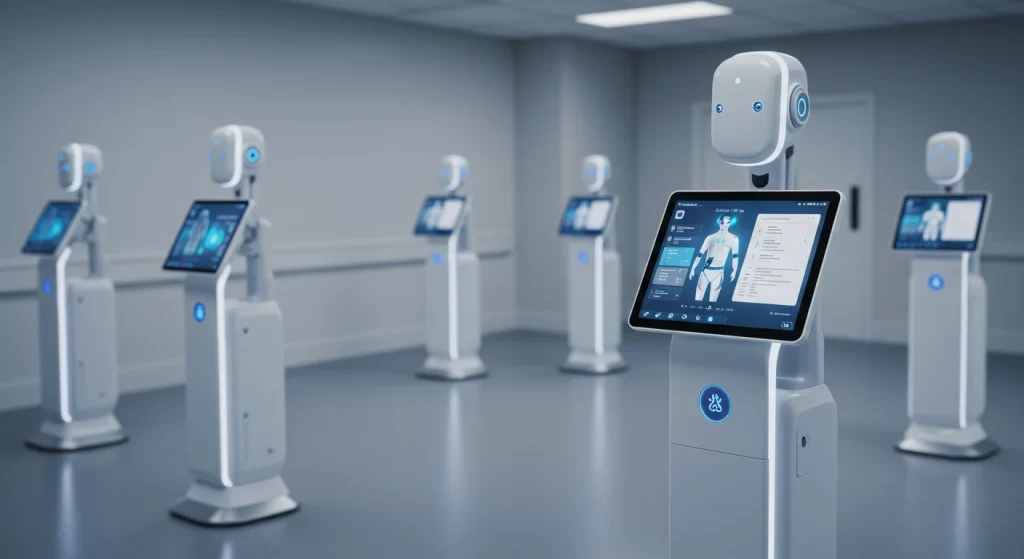
While specific AI medical scribe market data isn’t always separate, this segment drives growth in NLP and Clinical Documentation Improvement (CDI). Ambient speech technology adoption is occurring at an “unprecedented rate,” with around 60 ambient scribe solutions estimated to be available or implemented.
Adoption Trends in Healthcare
AI medical scribe adoption, especially ambient, is recent and accelerating:
- Speed. Implementations are rapid (e.g., Permanente Medical Group: 3,400+ physicians in 10 weeks). 79% of healthcare organizations report using AI.
- Primary Driver. Reducing clinician burnout and documentation burden.
- Current Stage. Implementation is widespread, but deep clinician adoption is early, especially in acute care vs. ambulatory settings. Typical uptake rates are 20-50%.
- Rollout Strategies. Often piloted with high-burden clinicians or volunteers. Peer word-of-mouth is crucial.
- Specialty Interest. High interest in primary care, mental health, emergency medicine (high volume/conversational).
- Patient Acceptance. Generally positive, appreciating increased physician attention. Transparency and consent are vital.
Momentum is strong, driven by the burnout crisis, but the market is maturing. Variable adoption and challenges in providing scalable value suggest ongoing evolution.
Key Players and Vendor Landscape
The market is dynamic and crowded (~60 ambient vendors). Key players include:
- Major Platforms. Microsoft (Nuance DAX), Google, Amazon (AWS HealthScribe).
- Specialized Vendors. Abridge, Ambience Healthcare, DeepScribe, Nabla, Suki.
- App-Based/Others. Freed AI, Athelas Scribe, NoteMD, Tali, Wavo Health, Heidi Health, Mutuo Health, Tortus, Sunoh.ai, Playback Health, Charting Hero.
- Hybrid/Service. ScribeEMR.
Vendors differentiate by:
- Core Technology. Ambient, voice-activated, hybrid; AI models used.
- EHR Integration. Agnostic vs. deep partnerships (e.g., Abridge/Microsoft with Epic).
- Specialty Focus. Tuning for specific fields.
- Pricing. Subscription, usage-based, enterprise.
- Additional Features. Coding suggestions, patient summaries, CDS prompts.
KLAS Research provides vendor performance insights, validating players like Abridge, Ambience Healthcare, DeepScribe, Microsoft, Nabla, and Suki, often highlighting EHR integration importance. ScribeEMR received “Best in KLAS” for virtual scribing. Market consolidation is likely. Vendors demonstrating superior tech, seamless integration, tangible outcomes (especially ROI), and reliability are best positioned.
Choosing the Right Solution: Selecting the Best AI Scribe for Medical Notes
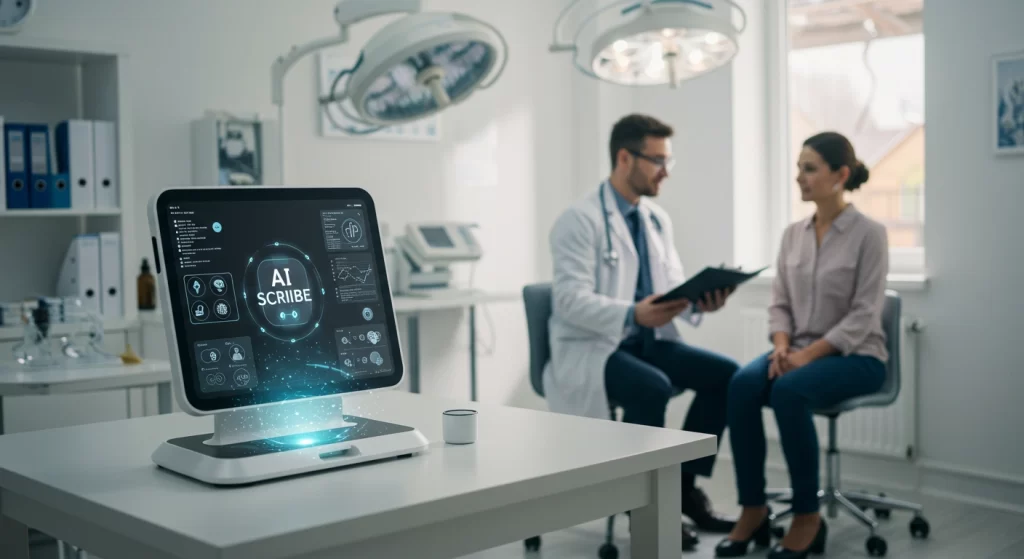
Selecting the right AI medical scribe requires careful evaluation; there’s no single “best AI scribe for notes”. Assess solutions against these criteria:
Accuracy and Reliability
- Verify Claims: Test performance in real-world scenarios via pilots/trials, beyond marketing claims (>95%).
- Test Robustness: Evaluate handling of accents, noise, multiple speakers, complex terminology.
- Evaluate Note Quality: Assess clinical relevance, structure, conciseness of generated scribe AI notes. How much editing is needed? Does it filter non-clinical talk?
Ease of Use and Workflow Integration
- User Experience: Intuitive interface, minimal training needed.
- EHR Integration: Critical. Check for seamless, bidirectional integration with your EHR. Direct data flow vs. copy-paste? Vendor partnerships?
- Workflow Impact: Should enhance, not hinder. Real-time/ambient capture vs. post-encounter recording? Note generation speed?
Customization and Specialty Fit
- Adaptability: Ability to customize templates, formatting, phrasing, detail level (“Customization Studios”?).
- Specialty Relevance: Ensure model is trained/adaptable for the specific specialty’s vocabulary and documentation needs.
- Language Support: Verify handling of multilingual conversations if needed.
Security and Compliance
- HIPAA Compliance: Non-negotiable. Verify status, require BAA.
- Security Measures: Inquire about encryption, secure storage/non-storage, access controls, audit trails.
- Certifications: Look for SOC 2, ISO 27001.
- Patient Consent: Ensure support for a clear consent process.
Vendor Support, Reputation, and Training
- Support Services: Evaluate responsiveness, technical support availability, issue handling.
- Reputation: Research track record via independent reviews (KLAS), testimonials, case studies, references.
- Training: Assess quality/availability of training resources.
AI medical scribe cost and Pricing Models
- Transparency: Understand the full structure (monthly fee? usage-based? tiers? implementation costs?).
- Total Cost of Ownership (TCO): Calculate including subscription, usage, implementation, training, maintenance.
- Return on Investment (ROI): Evaluate anticipated ROI (time savings, efficiency, coding accuracy, burnout reduction) against TCO.
Involve stakeholders (clinical, IT, revenue cycle, admin). Rigorous evaluation with piloting is essential to find the best AI scribe for medical notes for your organization.
The Future is Listening: What’s Next for AI Medical Scribes?
The AI medical scribe field is evolving rapidly.
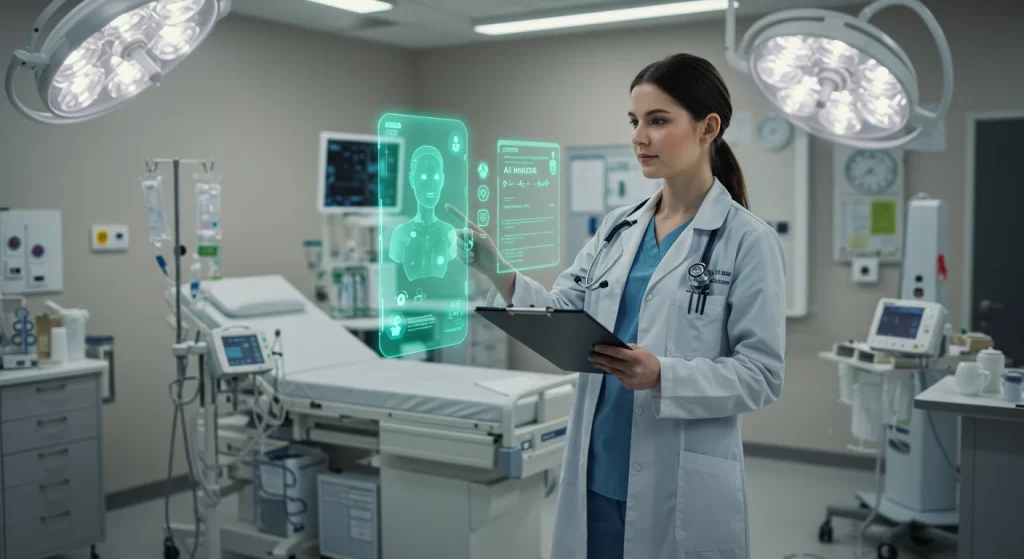
Advancements in Core Technologies (ASR, NLP, ML)
Expect improvements:
- Enhanced ASR. Better accuracy in noise/with diverse speakers, improved medical vocabulary handling.
- Sophisticated NLP. Deeper contextual understanding (LLMs like GPT-4), better summarization, more accurate extraction.
- Smarter ML. Faster adaptation to preferences, more personalized notes, potential predictive capabilities.
Deeper EHR Integration and Workflow Automation
Integration will become more dynamic:
- Intelligent EHR Interaction. Proactively pulling history, triggering actions within EHR. Gartner predicts GenAI in EHRs will cut documentation time 50% by 2027.
- Automating Adjacent Tasks. Generating referrals, pre-auth forms, patient instructions, queuing orders.
- Rise of AI Agents. More autonomous handling of multi-step clinical/admin workflows.
Expanding Capabilities: Beyond Documentation
Scribes will evolve into active clinical assistants:
- Enhanced Coding Support. More proficient suggestions (CPT, ICD-10, HCC).
- Clinical Decision Support (CDS). Real-time prompts during visits (potential diagnoses, guidelines, drug interactions, reminders).
- Data Insights. Analyzing aggregated, anonymized scribe AI notes for trends, quality improvement, research.
Broader Adoption Across Specialties and Roles
Adoption will broaden:
- Across Specialties. Increasingly tailored for complex fields (oncology, cardiology, surgery).
- Across Roles. Use by nurses, MAs, therapists, etc.
- Across Settings. Standard use in inpatient, specialty clinics, telehealth.
The AI medical scribe is poised to become a comprehensive clinical assistant, integral to efficient, effective healthcare delivery.
Conclusion
The AI medical scribe is a transformative technology addressing key healthcare challenges like documentation burden and physician burnout. By automating note-taking, medical scribe AI saves clinicians significant time, potentially improves documentation accuracy (scribe AI notes), enhances patient interaction, and offers cost advantages over human scribes. These benefits fuel rapid adoption.
However, challenges like ensuring accuracy (mitigating “hallucinations”), achieving seamless EHR integration, maintaining privacy/security, fostering clinician trust, and proving financial ROI persist. Selecting the “best AI scribe for notes” requires careful, context-specific evaluation.
The future points towards more sophisticated AI scribes with advanced core technologies, deeper workflow integration, and expanded capabilities like clinical decision support. The AI medical scribe is leading a shift towards more efficient, data-driven, and human-centered healthcare. Thoughtful selection and implementation are key to realizing its full potential.
Ready to revolutionize your clinical documentation? Partner with SPsoft to leverage our deep expertise in healthcare AI. We develop and integrate intelligent solutions, including custom AI medical scribe systems, tailored to your unique needs!
FAQ
What is an AI medical scribe?
An AI medical scribe is an AI-powered software tool that automatically listens to, transcribes, and structures conversations between medical providers and patients into clinical notes, automating documentation and reducing administrative burden.
How does an AI medical scribe work?
It uses Automatic Speech Recognition (ASR) to convert speech to text, Natural Language Processing (NLP) to understand context and extract medical information, and Machine Learning (ML) to learn preferences and improve accuracy.
What are the main benefits of using medical scribe AI?
Key benefits include significant time savings, reduced clinician burnout, potentially improved note accuracy/consistency, enhanced patient-provider interaction, and cost savings compared to human scribes.
Are AI scribes for medical notes accurate?
They can be highly accurate but are not perfect. Errors like transcription mistakes, omissions, or “hallucinations” can occur. Thorough physician review and editing of all scribe AI notes are essential.
Is using an AI medical scribe HIPAA compliant?
Reputable vendors design systems for HIPAA compliance with security measures like encryption, access controls, and audit trails. A Business Associate Agreement (BAA) is necessary.
What is the difference between ambient and non-ambient AI medical scribes?
Ambient scribes listen passively without commands, maximizing patient focus. Non-ambient (voice-activated/app-based) scribes require active start/stop commands, offering more user control but potentially more interaction during the visit.
Can AI scribe meeting notes replace manual note-taking entirely?
Not yet. While AI scribe meeting notes (clinical notes from encounters) greatly reduce manual effort, clinician review, editing, and approval are crucial due to potential errors and the need for nuanced judgment.
How long does it take to implement an AI medical scribe?
It varies. Simple app-based tools can be quick. Organization-wide implementation with EHR integration and training takes longer, influenced by EHR complexity, IT resources, and change management.
What is the best AI scribe for notes?
There’s no single “best AI scribe for notes.” The optimal choice depends on practice needs (accuracy, EHR integration, ease of use, customization, security, support, cost/ROI). Thorough evaluation and piloting are recommended.



